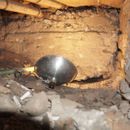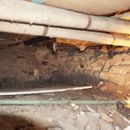Casting concrete to repair rubble foundation?
I have a crawlspace that leaks air badly in the winter and I would like to insulate (I live in Minneapolis, MN for reference). Upon embarking on the job, I uncovered a rubble foundation that is in need of repair. This foundation is part an old extension to the house and is of much lower quality than the original limestone brick foundation. It also looks as if it has been repaired at least once in its life as there are some random chunks of red brick and glass embedded in the wall which I doubt were original.
I understand that the usual repair would be to tuck-point new stones into the foundation, but because the access is so difficult I am wondering it there are any other options. Access is via a small opening in the basement wall but once inside clearance is very limited especially since there are large radiator pipes to contend with (see photo). Under the radiator pipes there is only about 18in and the width of the opening is about 30in.
As far as other alternatives to tuck-pointing, would it be possible to build a form on the inside of the wall and then cast concrete into the void? It appears that this method was used at some point for other parts of the foundation (to the left of the corner in the photos) and so far it looks like it is in good shape. If this is possible, any suggestions on concrete type? If casting concrete is inadvisable, does any one have any other suggestions?
Also, in the first photo you will see that there is a large void at the base of the dirt. The void is below the “grade” of the rest of the dirt floor so could just be filled in with dirt and rubble. Would this be a mistake? It would be next to impossible to tuck-point in this void without major excavation so could poured concrete be used here?
Lastly, in case it alters any of the advice, the crawlspace does not have any water problems. Our house sits atop and hill and has good drainage away from the foundation. Additionally, the specific wall in question is now located under a porch so there is next to no moisture on the other side of the wall.
Thank you in advance for any suggestions or advice.
GBA Detail Library
A collection of one thousand construction details organized by climate and house part












Replies
Also consider adding some wire mesh and then shotcrete from a hand mortar sprayer.
Frank,
The answer depends on who is doing the work and how big your budget is.
Possible solutions include jacking up that part of the house, demolishing the existing foundation, and installing a new foundation -- probably a job you would want to hire a contractor for -- to all kinds of cheap, temporary fixes.
What do you want? Who's doing the work? What can you afford?
There's lot so work to do if you can afford to do it, including the following:
Enlarging the access hole.
Lowering the floor of the crawl space to improve access.
Removing deteriorating sections of the wall to facilitate replacement.
Various types of wall repair.
Air sealing work.
Insulating the crawl space walls.
Installing a rat slab.
It's up to you to determine how much of this work you want to tackle, and how big your checkbook balance is.
Martin & Jon, Thank you very much for your suggestions and advice.
In answer to Martin questions, I hope to do as much of the work as possible. That said, I do not want to go about it foolishly and execute a repair that will not last, or make things worse. As far as the insulation is concerned, I am quite familiar with best practices when it comes to insulating and air sealing so for this post I would like to focus on how to repair the wall.
The proposal to jack up the house is definitely too complicated at this point. As I mentioned, the other side of the wall is currently under a screened porch so there would be no way to demolish the wall and rebuild without removing the porch... or at least the access is so bad under the porch that it would no doubt be ridiculously expensive.
So the main question for now is, what are my options for repairing this wall from the inside. I would greatly prefer the fix to be as simple as possible since working down there is a little tedious,That said, if the best solution is to repoint the foundation I would rather do that than rush through a repair that does not last. I have asked about casting concrete since it appears that technique was used previously in the space and would require less finesse in the tight space. I have also read that the use of portland cement based products could cause more harm than good which I definitely do not want.
If I am to repoint, I understand the need to remove all of the loose mortar and stones first but I would greatly appreciate any suggestions about mortar type. The original foundation for our house is definitely held together with lime mortar, but I am unsure about the crawlspace addition. Does that fact that it is so crumbly mean it is also lime based and should be replaced with a lime based mortar?
Lastly, in case it is important, the exterior of the wall looks in pretty good shape. It looks as if it has been skim coated with concrete which is showing a few cracks but nothing major. I know that the porch was built in 1994 and based on the access I cannot imagine the wall will have been skim coated any more recently than that. If it helps, I can attach a photo of the exterior wall. I have no idea, and there are no property records of when the addition was originally built.
My guess is that the interior side of a wall that stays dry is much less sensitive to the concerns about using a 100% portland cement based mortar with walls containing softer materials. Maybe type S?
Frank,
First, full disclosure: I am not an expert on historic mortars.
This does not appear to be an example of historic preservation. You have a crumbly foundation that has already been patched with modern concrete with only partial success. You have limited access and limited funds.
So here's my advice: Don't overthink this. Improve the access as best you can (if possible, by lowering the floor somewhat). Repair the foundation as best you can by removing the crumbly mortar and replacing the loose stones, setting these stones in a modern mortar mix. Your work will be an improvement over what you have. If you can, stucco the interior with a cement-based mortar when you are done repairing the stonework.
I wouldn't bother trying to build a single-sided concrete form in this cramped space. Single-sided concrete forms are hard to build, even when access is good.
Frank,
If you are still following this Q&A, could you update us on what you chose to do? I'd be curious if you came up with a good solution.